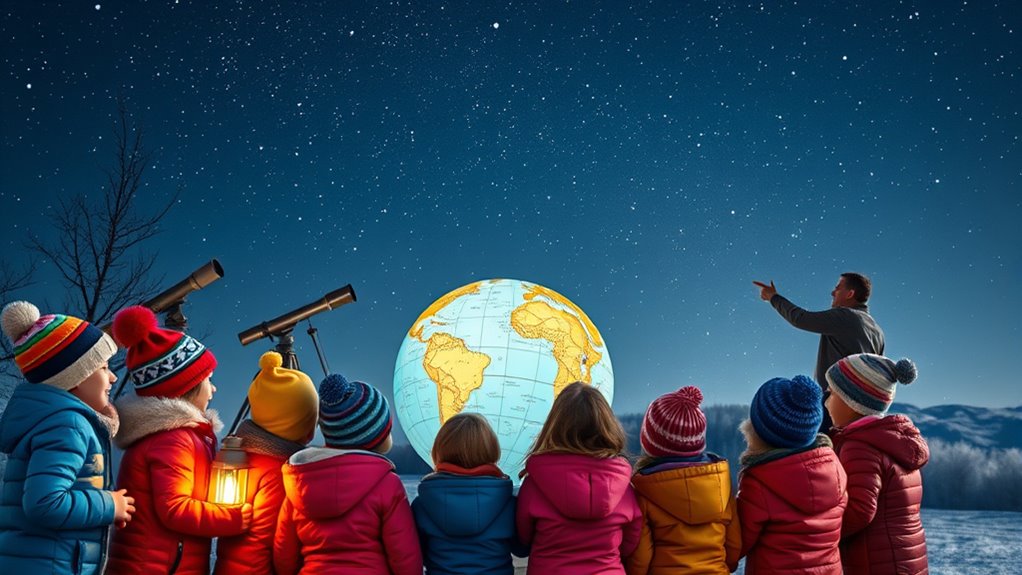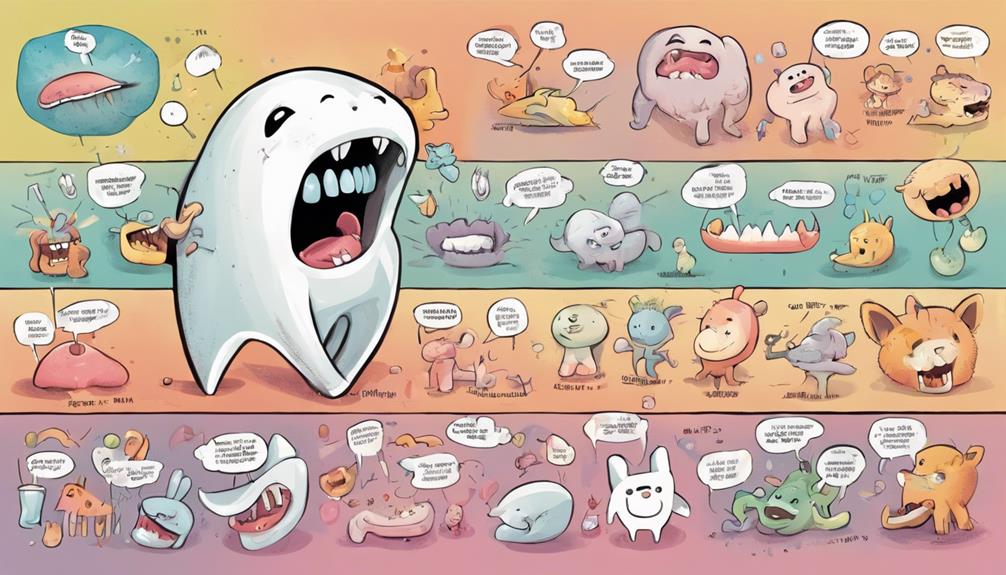To teach kids about the winter solstice and astronomy, start by explaining Earth’s tilt and how it affects sunlight. Use simple diagrams or models to show how the North Pole is tilted away from the sun during this time, resulting in the shortest day of the year. Talk about celestial events like solstices and how they mark key points in Earth’s orbit. Stay curious—there’s much more fascinating science to explore about our planet and stars.
Key Takeaways
- Use simple diagrams or models to illustrate Earth’s tilt and orbit around the sun.
- Explain that the winter solstice occurs when Earth’s tilt causes the least daylight in the Northern Hemisphere.
- Share cultural stories or traditions related to the solstice to make learning engaging and relevant.
- Observe the night sky during winter to identify constellations and planets visible at this time.
- Connect Earth’s tilt and orbit to everyday experiences like shorter days and changing seasons for better understanding.

Have you ever wondered what causes the shortest day of the year? When you teach kids about the winter solstice, you’re opening a door to understanding fundamental concepts about our solar system and the fascinating celestial events that happen throughout the year. The winter solstice occurs because of the Earth’s tilt and its orbit around the sun. As you explain this, you help children grasp how our planet’s axial tilt causes different parts of Earth to receive varying amounts of sunlight over the seasons. During the solstice, the North Pole is tilted furthest away from the sun, resulting in the least daylight hours of the year in the Northern Hemisphere. This is a perfect opportunity to introduce the idea of celestial events—those astronomical phenomena that happen in space and mark important points in Earth’s orbit.
Using simple diagrams or models can make these concepts more tangible for kids. You might show how the Earth’s tilt remains constant as it orbits the sun, leading to the changing angles of sunlight hitting different parts of the planet. This visual aid helps children understand why the days are shorter in winter and longer in summer. Explaining that the Earth’s position relative to the sun changes throughout the year, and that the solstice is just one of these key moments, makes the solar system’s dynamics more accessible. You can also discuss how other celestial events, like solstices and equinoxes, are tied to our planet’s position in space, emphasizing that these are universal phenomena observable from Earth. Recognizing the Earth’s tilt as a fundamental cause of seasonal changes helps deepen their understanding of celestial mechanics.
Encouraging kids to observe the night sky adds an interactive element to learning. During the winter months, the early sunset provides a chance to spot constellations and planets that are visible during this season. You can teach them how astronomers track celestial events and how ancient cultures celebrated the solstice, linking science with history and culture. This approach helps children see the bigger picture—that astronomy isn’t just about distant stars, but also about understanding our place in the universe. As you discuss the solar system, highlight how Earth’s tilt and orbit lead to the changing seasons, making the abstract idea of celestial mechanics more concrete for young learners.
Frequently Asked Questions
How Does the Winter Solstice Affect Local Weather Patterns?
You might notice that the winter solstice signals the start of colder weather, impacting local weather patterns. As the sun reaches its lowest point, days get shorter, and seasonal changes bring cooler temperatures and often more snow or rain. This shift influences local weather by reducing sunlight and heat, making it feel colder. Understanding this helps you see how the winter solstice shapes seasonal changes and weather conditions in your area.
What Are Some Traditional Winter Solstice Celebrations Worldwide?
You can explore traditional winter solstice celebrations worldwide, where ancient rituals and cultural festivals play a significant role. In China, people celebrate Dongzhi with family gatherings and special foods. In Scandinavia, Yule involves feasts and decorating with greenery. In Mexico, the feast of the Winter Solstice honors indigenous traditions. These festivities highlight how different cultures honor the longest night of the year through meaningful rituals and communal celebrations.
Can Children Observe the Earth’s Tilt During the Solstice?
Yes, you can observe Earth’s tilt during the solstice, as it’s like a cosmic dance revealing seasonal changes. When you look at the Sun’s position or note the length of shadows, you’re witnessing Earth’s tilt in action. This tilt causes the changing seasons, and during the winter solstice, it’s at its most extreme. Kids can see these shifts firsthand, making the invisible tilt a fascinating part of nature’s grand choreography.
How Does the Earth’s Orbit Influence the Seasons Beyond the Solstice?
Earth’s orbit influences the seasons through its tilt and orbital eccentricity. As you observe, Earth’s tilt causes seasonal changes in sunlight, making summers warmer and winters colder. Orbital eccentricity slightly alters the distance from the Sun throughout the year, impacting the intensity of seasons. Together, these factors create the pattern of seasons you see, with the Earth’s tilt playing a primary role and eccentricity adding subtle variations.
Are There Any Myths Associated With the Winter Solstice?
Yes, many myths and folklore legends surround the winter solstice. You might hear stories about mythical creatures like the Holly King or the Oak King, representing the sun’s rebirth. These legends often symbolize the return of longer days and the triumph of light over darkness. Such myths help people celebrate the season’s symbolism, blending cultural traditions with stories of mythical beings that mark this special time of year.
Conclusion
By teaching kids about the winter solstice and astronomy, you’re helping them understand the world’s natural rhythms. Did you know that the Earth’s tilt causes the winter solstice, the shortest day of the year? Sharing this fact makes the science more exciting and relatable. As you explore the cosmos together, you’re not just teaching facts—you’re inspiring curiosity and wonder that can last a lifetime. Keep exploring, and watch their fascination grow!









